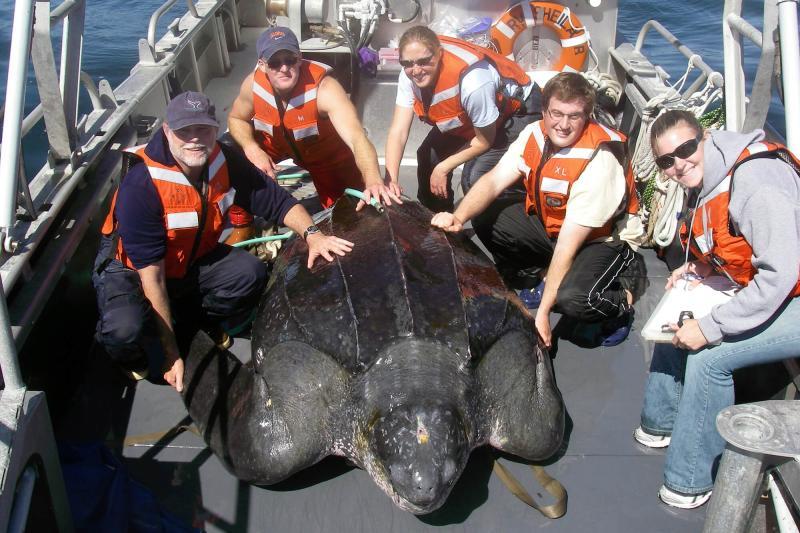
Celebrating the people and partnerships saving Pacific Leatherback Sea Turtles
by NOAA Fisheries 4 Jun 2023 06:37 AEST

Scientists tag a 607 kg Leatherback sea turtle on the deck of the R/V Sheila B before releasing it back to the water. Left to Right: Scott Benson, John Douglas, Denise Greg, Mike James, Lauren Donnelly-Crocker © Heather Harris
Marking the 50th year of the passage of the Endangered Species Act, we are shining a spotlight on the biologists and partnerships saving Pacific Leatherback Sea Turtles from extinction.
What's it like to work every day to save a species? NOAA Fisheries is working to recover five West Coast Species in the Spotlight. They are among nine species nationally that NOAA Fisheries has identified as facing a high risk of extinction, and where concerted recovery actions can make the difference.
Each species has unique recovery challenges. Giant Leatherback turtles that feed off the West Coast depend on nesting beaches in Indonesia. Working internationally, we need to protect beaches where turtles and their eggs could be in jeopardy.
Scott Benson, lead investigator of the California leatherback research project, shares with us why Pacific Leatherback Sea Turtles are worth saving, his proudest achievements to date, and where more work is needed.
What's one thing you want people to know about Pacific leatherback sea turtles?
Leatherback turtles have been on our planet for millions of years, since the age of the dinosaurs. Sadly, the Pacific leatherback turtle population that visits U.S. West Coast waters seasonally to feed on abundant jellyfish has declined by 80 percent during the past 30 years. The decline of Pacific leatherbacks is due to significant threats on nesting beaches and in the marine environment including:
- Bycatch in commercial fisheries
- Directed harvest of adults and eggs
- Loss of nesting habitat due to coastal development and sea level rise
- Vessel strikes
- Ingestion of and entanglement in marine debris
NOAA declared this majestic marine animal a "Species in the Spotlight" because it is at risk of extinction in the Pacific Ocean within the next few decades.
Why is the species important to protect and recover?
Adult leatherback turtles are large animals and weigh more than 1,000 pounds. They eat gelatinous zooplankton and must consume more than 50 percent of their body mass daily to meet calorie requirements, grow, and reproduce. Leatherback turtles perform an important function in marine ecosystems by maintaining predation pressure on sea jellies that consume commercially important larval stage fish.
What are you most proud of?
I am pleased and honored to have had the opportunity to contribute knowledge about the origin of leatherback turtles that visit the U.S. West Coast waters from distant beaches on the other side of the Pacific Ocean. These data have contributed to defining and designating critical habitat areas in U.S. West Coast waters. They have revealed that Pacific leatherbacks are also critical to the marine ecosystem in multiple Pacific nations and the international high seas.
Where do we have more work to do?
The Endangered Species Act has been an incredibly effective tool for the conservation and recovery of multiple marine species. However, its impact is primarily limited to U.S. territorial waters. As a result, U.S. waters are the safest places in the Pacific Ocean for leatherback turtles. Fishery bycatch is the greatest threat to leatherback turtles in the Pacific Ocean and around the world. U.S. fisheries are careful to avoid interaction with leatherbacks and when interactions do occur, outcomes are rarely fatal. We need to encourage other Pacific nations to adopt better gear and methodologies to ensure the recovery of Pacific leatherback turtles. Safeguarding U.S. waters alone won't be enough for this extremely long-distance traveler.
Species in the Spotlight
We know we can't do this alone. A major component of the Species in the Spotlight initiative is to expand partnerships and motivate individuals to work with us to get these species on the road to recovery.
As part of our Species in the Spotlight initiative, NOAA Fisheries developed a 2021–2025 Priority Action Plan for the Pacific leatherback, which details the key conservation efforts that are needed to recover this critically endangered species. Without focused efforts in the Pacific, leatherbacks may not recover and may become eliminated from the entire ocean basin.
Together with the U.S. FWS, we identified the following priority actions for 2021-2025:
- Reduce fisheries bycatch and in-water harvest
- Improve protection on nesting beaches
- Support in-water research and monitoring to inform conservation actions
- Foster cooperation with international partners
- Encourage public engagement